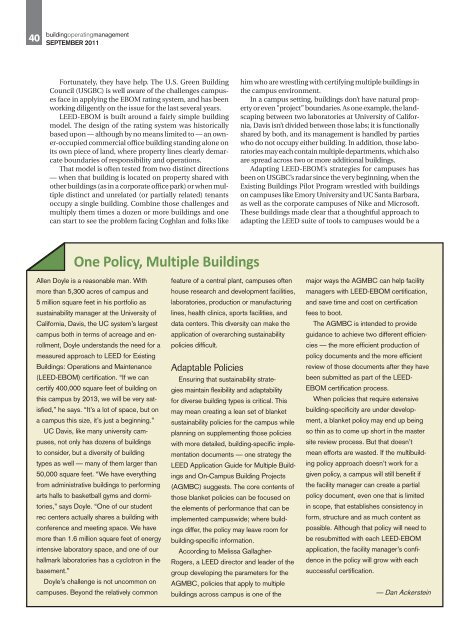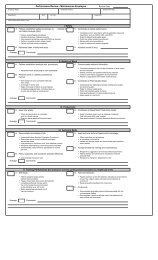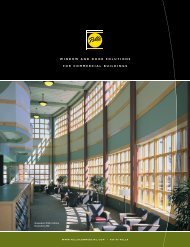Building Operating Management September 2011 - FacilitiesNet
Building Operating Management September 2011 - FacilitiesNet
Building Operating Management September 2011 - FacilitiesNet
Create successful ePaper yourself
Turn your PDF publications into a flip-book with our unique Google optimized e-Paper software.
40<br />
buildingoperatingmanagement<br />
SEPTEMBER <strong>2011</strong><br />
Fortunately, they have help. The U.S. Green <strong>Building</strong><br />
Council (USGBC) is well aware of the challenges campuses<br />
face in applying the EBOM rating system, and has been<br />
working diligently on the issue for the last several years.<br />
LEED-EBOM is built around a fairly simple building<br />
model. The design of the rating system was historically<br />
based upon — although by no means limited to — an owner-occupied<br />
commercial office building standing alone on<br />
its own piece of land, where property lines clearly demarcate<br />
boundaries of responsibility and operations.<br />
That model is often tested from two distinct directions<br />
— when that building is located on property shared with<br />
other buildings (as in a corporate office park) or when multiple<br />
distinct and unrelated (or partially related) tenants<br />
occupy a single building. Combine those challenges and<br />
multiply them times a dozen or more buildings and one<br />
can start to see the problem facing Coghlan and folks like<br />
him who are wrestling with certifying multiple buildings in<br />
the campus environment.<br />
In a campus setting, buildings don’t have natural property<br />
or even ”project” boundaries. As one example, the landscaping<br />
between two laboratories at University of California,<br />
Davis isn’t divided between those labs; it is functionally<br />
shared by both, and its management is handled by parties<br />
who do not occupy either building. In addition, those laboratories<br />
may each contain multiple departments, which also<br />
are spread across two or more additional buildings.<br />
Adapting LEED-EBOM’s strategies for campuses has<br />
been on USGBC’s radar since the very beginning, when the<br />
Existing <strong>Building</strong>s Pilot Program wrestled with buildings<br />
on campuses like Emory University and UC Santa Barbara,<br />
as well as the corporate campuses of Nike and Microsoft.<br />
These buildings made clear that a thoughtful approach to<br />
adapting the LEED suite of tools to campuses would be a<br />
One Policy, Multiple <strong>Building</strong>s<br />
Allen Doyle is a reasonable man. With<br />
more than 5,300 acres of campus and<br />
5 million square feet in his portfolio as<br />
sustainability manager at the University of<br />
California, Davis, the UC system’s largest<br />
campus both in terms of acreage and enrollment,<br />
Doyle understands the need for a<br />
measured approach to LEED for Existing<br />
<strong>Building</strong>s: Operations and Maintenance<br />
(LEED-EBOM) certifi cation. “If we can<br />
certify 400,000 square feet of building on<br />
this campus by 2013, we will be very satisfi<br />
ed,” he says. “It’s a lot of space, but on<br />
a campus this size, it’s just a beginning.”<br />
UC Davis, like many university campuses,<br />
not only has dozens of buildings<br />
to consider, but a diversity of building<br />
types as well — many of them larger than<br />
50,000 square feet. “We have everything<br />
from administrative buildings to performing<br />
arts halls to basketball gyms and dormitories,”<br />
says Doyle. “One of our student<br />
rec centers actually shares a building with<br />
conference and meeting space. We have<br />
more than 1.6 million square feet of energy<br />
intensive laboratory space, and one of our<br />
hallmark laboratories has a cyclotron in the<br />
basement.”<br />
Doyle’s challenge is not uncommon on<br />
campuses. Beyond the relatively common<br />
feature of a central plant, campuses often<br />
house research and development facilities,<br />
laboratories, production or manufacturing<br />
lines, health clinics, sports facilities, and<br />
data centers. This diversity can make the<br />
application of overarching sustainability<br />
policies diffi cult.<br />
Adaptable Policies<br />
Ensuring that sustainability strategies<br />
maintain fl exibility and adaptability<br />
for diverse building types is critical. This<br />
may mean creating a lean set of blanket<br />
sustainability policies for the campus while<br />
planning on supplementing those policies<br />
with more detailed, building-specifi c implementation<br />
documents — one strategy the<br />
LEED Application Guide for Multiple <strong>Building</strong>s<br />
and On-Campus <strong>Building</strong> Projects<br />
(AGMBC) suggests. The core contents of<br />
those blanket policies can be focused on<br />
the elements of performance that can be<br />
implemented campuswide; where buildings<br />
differ, the policy may leave room for<br />
building-specifi c information.<br />
According to Melissa Gallagher-<br />
Rogers, a LEED director and leader of the<br />
group developing the parameters for the<br />
AGMBC, policies that apply to multiple<br />
buildings across campus is one of the<br />
major ways the AGMBC can help facility<br />
managers with LEED-EBOM certifi cation,<br />
and save time and cost on certifi cation<br />
fees to boot.<br />
The AGMBC is intended to provide<br />
guidance to achieve two different effi ciencies<br />
— the more effi cient production of<br />
policy documents and the more effi cient<br />
review of those documents after they have<br />
been submitted as part of the LEED-<br />
EBOM certifi cation process.<br />
When policies that require extensive<br />
building-specifi city are under development,<br />
a blanket policy may end up being<br />
so thin as to come up short in the master<br />
site review process. But that doesn’t<br />
mean efforts are wasted. If the multibuilding<br />
policy approach doesn’t work for a<br />
given policy, a campus will still benefi t if<br />
the facility manager can create a partial<br />
policy document, even one that is limited<br />
in scope, that establishes consistency in<br />
form, structure and as much content as<br />
possible. Although that policy will need to<br />
be resubmitted with each LEED-EBOM<br />
application, the facility manager’s confi -<br />
dence in the policy will grow with each<br />
successful certifi cation.<br />
— Dan Ackerstein





